List of birds of Italy
This is a list of the bird species recorded in Italy. The avifauna of Italy included a total of 563 species recorded in the wild by January 2020.[1] Of these species, 175 are accidental, 11 have been introduced by humans, and one has been extirpated.
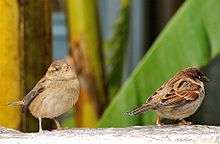
This list's taxonomic treatment (designation and sequence of orders, families and species) and nomenclature (English and scientific names) are those of The Clements Checklist of Birds of the World, 2019 edition.[2]
The following tags have been used to highlight some categories of occurrence. The notes of population status, such as "endangered", apply to the worldwide population, not that only in Italy.
- (A) Accidental - a species that rarely or accidentally occurs in Italy
- (I) Introduced - a species introduced by humans directly or indirectly to Italy
Ducks, geese, and waterfowl
Order: Anseriformes Family: Anatidae
Anatidae includes the ducks and most duck-like waterfowl, such as geese and swans. These birds are adapted to an aquatic existence with webbed feet, flattened bills, and feathers that are excellent at shedding water due to an oily coating.
- Snow goose, Anser caerulescens (A)
- Graylag goose, Anser anser
- Greater white-fronted goose, Anser albifrons
- Lesser white-fronted goose, Anser erythropus (A) (vulnerable)
- Taiga bean-goose, Anser fabalis
- Tundra bean-goose, Anser serrirostris
- Pink-footed goose, Anser brachyrhynchus (A)
- Brant, Branta bernicla
- Barnacle goose, Branta leucopsis
- Canada goose, Branta canadensis
- Red-breasted goose, Branta ruficollis (vulnerable)
- Mute swan, Cygnus olor (I)
- Tundra swan, Cygnus columbianus
- Whooper swan, Cygnus cygnus
- Egyptian goose, Alopochen aegyptiaca (A)
- Ruddy shelduck, Tadorna ferruginea
- Common shelduck, Tadorna tadorna
- Mandarin duck, Aix galericulata
- Baikal teal, Sibirionetta formosa (A) (vulnerable)
- Garganey, Spatula querquedula
- Blue-winged teal, Spatula discors (A)
- Northern shoveler, Spatula clypeata
- Gadwall, Mareca strepera
- Eurasian wigeon, Mareca penelope
- American wigeon, Mareca americana (A)
- Mallard, Anas platyrhynchos
- Northern pintail, Anas acuta
- Green-winged teal, Anas crecca
- Marbled teal, Marmaronetta angustirostris (vulnerable)
- Red-crested pochard, Netta rufina
- Canvasback, Aythya valisineria (A)
- Common pochard, Aythya ferina
- Ring-necked duck, Aythya collaris (A)
- Ferruginous duck, Aythya nyroca (near-threatened)
- Tufted duck, Aythya fuligula
- Greater scaup, Aythya marila
- King eider, Somateria spectabilis (A)
- Common eider, Somateria mollissima
- Harlequin duck, Histrionicus histrionicus (A)
- Velvet scoter, Melanitta fusca (vulnerable)
- Common scoter, Melanitta nigra
- Long-tailed duck, Clangula hyemalis
- Bufflehead, Bucephala albeola (A)
- Common goldeneye, Bucephala clangula
- Smew, Mergellus albellus
- Common merganser, Mergus merganser
- Red-breasted merganser, Mergus serrator
- Ruddy duck, Oxyura jamaicensis (A)
- White-headed duck, Oxyura leucocephala (endangered)
Pheasants, grouse, and allies
Order: Galliformes Family: Phasianidae
The Phasianidae are a family of terrestrial birds. In general, they are plump (although they vary in size) and have broad, relatively short wings.
- Common quail, Coturnix coturnix (I)
- Rock partridge, Alectoris graeca (near-threatened)
- Red-legged partridge, Alectoris rufa
- Barbary partridge, Alectoris barbara
- Erckel's francolin, Pternistis erckelii (I)
- Black francolin, Francolinus francolinus (I)
- Ring-necked pheasant, Phasianus colchicus (I)
- Gray partridge, Perdix perdix
- Western capercaillie, Tetrao urogallus
- Black grouse, Tetrao tetrix
- Hazel grouse, Bonasa bonasia
- Rock ptarmigan, Lagopus muta
Flamingos
Order: Phoenicopteriformes Family: Phoenicopteridae
Flamingos are gregarious wading birds, usually 3 to 5 feet (0.9 to 1.5 m) tall, found in both the Western and Eastern Hemispheres. Flamingos filter-feed on shellfish and algae. Their oddly shaped beaks are specially adapted to separate mud and silt from the food they consume and, uniquely, are used upside-down.
- Greater flamingo, Phoenicopterus roseus
Grebes
Order: Podicipediformes Family: Podicipedidae
Grebes are small to medium-large freshwater diving birds. They have lobed toes and are excellent swimmers and divers. However, they have their feet placed far back on the body, making them quite ungainly on land.
- Little grebe, Tachybaptus ruficollis
- Horned grebe, Podiceps auritus (vulnerable)
- Red-necked grebe, Podiceps grisegena
- Great crested grebe, Podiceps cristatus
- Eared grebe, Podiceps nigricollis
Pigeons and doves
Order: Columbiformes Family: Columbidae
Pigeons and doves are stout-bodied birds with short necks and short slender bills with a fleshy cere.
- Rock pigeon, Columba livia
- Stock pigeon, Columba oenas
- Common wood-pigeon, Columba palumbus
- European turtle-dove, Streptopelia turtur (vulnerable)
- Oriental turtle-dove, Streptopelia orientalis (A)
- Eurasian collared-dove, Streptopelia decaocto
- Laughing dove, Spilopelia senegalensis
Sandgrouse
Order: Pterocliformes Family: Pteroclidae
Sandgrouse have small, pigeon like heads and necks, but sturdy compact bodies. They have long pointed wings and sometimes tails and a fast direct flight. Flocks fly to watering holes at dawn and dusk. Their legs are feathered down to the toes.
- Pallas's sandgrouse, Syrrhaptes paradoxus (A)
- Pin-tailed sandgrouse, Pterocles alchata (A)
- Spotted sandgrouse, Pterocles senegallus (A)
Bustards
Order: Otidiformes Family: Otididae
Bustards are large terrestrial birds mainly associated with dry open country and steppes in the Old World. They are omnivorous and nest on the ground. They walk steadily on strong legs and big toes, pecking for food as they go. They have long broad wings with "fingered" wingtips and striking patterns in flight. Many have interesting mating displays.
- Great bustard, Otis tarda (A) (vulnerable)
- Houbara bustard, Chlamydotis undulata (A) (vulnerable)
- Macqueen's bustard, Chlamydotis macqueenii (A) (vulnerable)
- Little bustard, Tetrax tetrax (near-threatened)
Cuckoos
Order: Cuculiformes Family: Cuculidae
The family Cuculidae includes cuckoos, roadrunners and anis. These birds are of variable size with slender bodies, long tails and strong legs. The Old World cuckoos are brood parasites.
- Great spotted cuckoo, Clamator glandarius
- Yellow-billed cuckoo, Coccyzus americanus (A)
- Black-billed cuckoo, Coccyzus erythropthalmus (A)
- Common cuckoo, Cuculus canorus
Nightjars and allies
Order: Caprimulgiformes Family: Caprimulgidae
Nightjars are medium-sized nocturnal birds that usually nest on the ground. They have long wings, short legs and very short bills. Most have small feet, of little use for walking, and long pointed wings. Their soft plumage is camouflaged to resemble bark or leaves.
- Red-necked nightjar, Caprimulgus ruficollis (A)
- Eurasian nightjar, Caprimulgus europaeus
- Egyptian nightjar, Caprimulgus aegyptius (A)
Swifts
Order: Caprimulgiformes Family: Apodidae
Swifts are small birds which spend the majority of their lives flying. These birds have very short legs and never settle voluntarily on the ground, perching instead only on vertical surfaces. Many swifts have long swept-back wings which resemble a crescent or boomerang.
- Alpine swift, Tachymarptis melba
- Common swift, Apus apus
- Pallid swift, Apus pallidus
- Little swift, Apus affinis (A)
- White-rumped swift, Apus caffer (A)
Rails, gallinules, and coots
Order: Gruiformes Family: Rallidae
Rallidae is a large family of small to medium-sized birds which includes the rails, crakes, coots and gallinules. Typically they inhabit dense vegetation in damp environments near lakes, swamps or rivers. In general they are shy and secretive birds, making them difficult to observe. Most species have strong legs and long toes which are well adapted to soft uneven surfaces. They tend to have short, rounded wings and to be weak fliers.
- Water rail, Rallus aquaticus
- Corn crake, Crex crex
- Spotted crake, Porzana porzana
- Eurasian moorhen, Gallinula chloropus
- Red-knobbed coot, Fulica cristata (A)
- Eurasian coot, Fulica atra
- Allen's gallinule, Porphyrio alleni (A)
- Purple gallinule, Porphyrio martinicus (A)
- Western swamphen, Porphyrio porphyrio
- African swamphen, Porphyrio madagascariensis (A)
- Striped crake, Amaurornis marginalis (A)
- Little crake, Zapornia parva
- Baillon's crake, Zapornia pusilla
Cranes
Order: Gruiformes Family: Gruidae
Cranes are large, long-legged and long-necked birds. Unlike the similar-looking but unrelated herons, cranes fly with necks outstretched, not pulled back. Most have elaborate and noisy courting displays or "dances".
- Demoiselle crane, Anthropoides virgo (A)
- Common crane, Grus grus
Thick-knees
Order: Charadriiformes Family: Burhinidae
The thick-knees are a group of largely tropical waders in the family Burhinidae. They are found worldwide within the tropical zone, with some species also breeding in temperate Europe and Australia. They are medium to large waders with strong black or yellow-black bills, large yellow eyes and cryptic plumage. Despite being classed as waders, most species have a preference for arid or semi-arid habitats.
- Eurasian thick-knee, Burhinus oedicnemus
Stilts and avocets
Order: Charadriiformes Family: Recurvirostridae
Recurvirostridae is a family of large wading birds, which includes the avocets and stilts. The avocets have long legs and long up-curved bills. The stilts have extremely long legs and long, thin, straight bills.
- Black-winged stilt, Himantopus himantopus
- Pied avocet, Recurvirostra avosetta
Oystercatchers
Order: Charadriiformes Family: Haematopodidae
The oystercatchers are large and noisy plover-like birds, with strong bills used for smashing or prising open molluscs.
- Eurasian oystercatcher, Haematopus ostralegus
Plovers and lapwings
Order: Charadriiformes Family: Charadriidae
The family Charadriidae includes the plovers, dotterels and lapwings. They are small to medium-sized birds with compact bodies, short, thick necks and long, usually pointed, wings. They are found in open country worldwide, mostly in habitats near water.
- Black-bellied plover, Pluvialis squatarola
- European golden-plover, Pluvialis apricaria
- American golden-plover, Pluvialis dominica (A)
- Pacific golden-plover, Pluvialis fulva (A)
- Northern lapwing, Vanellus vanellus (near-threatened0
- Spur-winged lapwing, Vanellus spinosus (A)
- Sociable lapwing, Vanellus gregarius (A) (critically endangered)
- White-tailed lapwing, Vanellus leucurus (A)
- Lesser sand-plover, Charadrius mongolus (A)
- Greater sand-plover, Charadrius leschenaultii (A)
- Caspian plover, Charadrius asiaticus (A)
- Kittlitz's plover, Charadrius pecuarius (A)
- Kentish plover, Charadrius alexandrinus
- Common ringed plover, Charadrius hiaticula
- Little ringed plover, Charadrius dubius
- Eurasian dotterel, Charadrius morinellus
Sandpipers and allies
Order: Charadriiformes Family: Scolopacidae
Scolopacidae is a large diverse family of small to medium-sized shorebirds including the sandpipers, curlews, godwits, shanks, tattlers, woodcocks, snipes, dowitchers and phalaropes. The majority of these species eat small invertebrates picked out of the mud or soil. Variation in length of legs and bills enables multiple species to feed in the same habitat, particularly on the coast, without direct competition for food.
- Upland sandpiper, Bartramia longicauda (A)
- Whimbrel, Numenius phaeopus
- Slender-billed curlew, Numenius tenuirostris (A) (critically endangered)
- Eurasian curlew, Numenius arquata (near-threatened)
- Bar-tailed godwit, Limosa lapponica (near-threatened)
- Black-tailed godwit, Limosa limosa (near-threatened)
- Ruddy turnstone, Arenaria interpres
- Red knot, Calidris canutus (near-threatened)
- Ruff, Calidris pugnax
- Broad-billed sandpiper, Calidris falcinellus
- Curlew sandpiper, Calidris ferruginea
- Temminck's stint, Calidris temminckii
- Red-necked stint, Calidris ruficollis (A) (near-threatened)
- Sanderling, Calidris alba
- Dunlin, Calidris alpina
- Purple sandpiper, Calidris maritima
- Baird's sandpiper, Calidris bairdii (A)
- Little stint, Calidris minuta
- Least sandpiper, Calidris minutilla (A)
- White-rumped sandpiper, Calidris fuscicollis (A)
- Buff-breasted sandpiper, Calidris subruficollis (A) (near-threatened)
- Pectoral sandpiper, Calidris melanotos
- Long-billed dowitcher, Limnodromus scolopaceus (A)
- Jack snipe, Lymnocryptes minimus
- Eurasian woodcock, Scolopax rusticola
- Great snipe, Gallinago media (near-threatened)
- Common snipe, Gallinago gallinago
- Pin-tailed snipe, Gallinago stenura (A)
- Terek sandpiper, Xenus cinereus
- Wilson's phalarope, Phalaropus tricolor (A)
- Red-necked phalarope, Phalaropus lobatus
- Red phalarope, Phalaropus fulicarius
- Common sandpiper, Actitis hypoleucos
- Spotted sandpiper, Actitis macularia (A)
- Green sandpiper, Tringa ochropus
- Spotted redshank, Tringa erythropus
- Common greenshank, Tringa nebularia
- Willet, Tringa semipalmata (A)
- Lesser yellowlegs, Tringa flavipes (A)
- Marsh sandpiper, Tringa stagnatilis
- Wood sandpiper, Tringa glareola
- Common redshank, Tringa totanus
Buttonquail
Order: Charadriiformes Family: Turnicidae
The buttonquail are small, drab, running birds which resemble the true quails. The female is the brighter of the sexes and initiates courtship. The male incubates the eggs and tends the young.
- Small buttonquail, Turnix sylvaticus
Pratincoles and coursers
Order: Charadriiformes Family: Glareolidae
Glareolidae is a family of wading birds comprising the pratincoles, which have short legs, long pointed wings and long forked tails, and the coursers, which have long legs, short wings and long, pointed bills which curve downwards.
- Cream-colored courser, Cursorius cursor (A)
- Collared pratincole, Glareola pratincola
- Black-winged pratincole, Glareola nordmanni (A) (near-threatened)
Skuas and jaegers
Order: Charadriiformes Family: Stercorariidae
The family Stercorariidae are, in general, medium to large birds, typically with grey or brown plumage, often with white markings on the wings. They nest on the ground in temperate and arctic regions and are long-distance migrants.
- Great skua, Stercorarius skua
- Pomarine jaeger, Stercorarius pomarinus
- Parasitic jaeger, Stercorarius parasiticus
- Long-tailed jaeger, Stercorarius longicaudus
Auks, murres, and puffins
Order: Charadriiformes Family: Alcidae
Auks are superficially similar to penguins due to their black-and-white colours, their upright posture and some of their habits, however they are not related to the penguins and differ in being able to fly. Auks live on the open sea, only deliberately coming ashore to nest.
- Dovekie, Alle alle (A)
- Common murre, Uria aalge (A)
- Razorbill, Alca torda (near-threatened)
- Atlantic puffin, Fratercula arctica (vulnerable)
Gulls, terns, and skimmers
Order: Charadriiformes Family: Laridae
Laridae is a family of medium to large seabirds, the gulls, terns, and skimmers. Gulls are typically grey or white, often with black markings on the head or wings. They have stout, longish bills and webbed feet. Terns are a group of generally medium to large seabirds typically with grey or white plumage, often with black markings on the head. Most terns hunt fish by diving but some pick insects off the surface of fresh water. Terns are generally long-lived birds, with several species known to live in excess of 30 years.
- Black-legged kittiwake, Rissa tridactyla (vulnerable
- Ivory gull, Pagophila eburnea (A) (near-threatened)
- Sabine's gull, Xema sabini (A)
- Slender-billed gull, Chroicocephalus genei
- Gray-hooded gull, Chroicocephalus cirrocephalus (A)
- Black-headed gull, Chroicocephalus ridibundus
- Little gull, Hydrocoloeus minutus
- Ross's gull, Rhodostethia rosea (A)
- Laughing gull, Leucophaeus atricilla (A)
- Franklin's gull, Leucophaeus pipixcan (A)
- Mediterranean gull, Ichthyaetus melanocephalus
- Pallas's gull, Ichthyaetus ichthyaetus
- Audouin's gull, Ichthyaetus audouinii
- Mew gull, Larus canus
- Ring-billed gull, Larus delawarensis (A)
- Herring gull, Larus argentatus
- Yellow-legged gull, Larus michahellis
- Caspian gull, Larus cachinnans
- Iceland gull, Larus glaucoides (A)
- Lesser black-backed gull, Larus fuscus
- Glaucous gull, Larus hyperboreus (A)
- Great black-backed gull, Larus marinus
- Sooty tern, Onychoprion fuscatus (A)
- Little tern, Sternula albifrons
- Gull-billed tern, Gelochelidon nilotica
- Caspian tern, Hydroprogne caspia
- Black tern, Chlidonias niger
- White-winged tern, Chlidonias leucopterus
- Whiskered tern, Chlidonias hybrida
- Roseate tern, Sterna dougallii (A)
- Common tern, Sterna hirundo
- Arctic tern, Sterna paradisaea (A)
- Sandwich tern, Thalasseus sandvicensis
- Lesser crested tern, Thalasseus bengalensis
Loons
Order: Gaviiformes Family: Gaviidae
Loons, known as divers in Europe, are a group of aquatic birds found in many parts of North America and northern Europe. They are the size of a large duck or small goose, which they somewhat resemble when swimming, but to which they are completely unrelated.
- Red-throated loon, Gavia stellata
- Arctic loon, Gavia arctica
- Common loon, Gavia immer
- Yellow-billed loon, Gavia adamsii (A) (near-threatened)
Albatrosses
Order: Procellariiformes Family: Diomedeidae
The albatrosses are among the largest flying birds, with long, narrow wings for gliding. The majority are found in the Southern Hemisphere with only vagrants occurring in the North Atlantic.
- Black-browed albatross, Thalassarche melanophris (A)
- Wandering albatross, Diomedea exulans (A)
Southern storm-petrels
Order: Procellariiformes Family: Oceanitidae
Southern storm petrels, are seabirds in the family Oceanitidae, part of the order Procellariiformes. These smallest of seabirds feed on planktonic crustaceans and small fish picked from the surface, typically while hovering. Their flight is fluttering and sometimes bat-like.
- Wilson's storm-petrel, Oceanites oceanicus (A)
Northern storm-petrels
Order: Procellariiformes Family: Hydrobatidae
The northern storm-petrels are relatives of the petrels and are the smallest seabirds. They feed on planktonic crustaceans and small fish picked from the surface, typically while hovering. The flight is fluttering and sometimes bat-like.
- European storm-petrel, Hydrobates pelagicus
- Leach's storm-petrel, Oceanodroma leucorhoa (A)
- Swinhoe's storm-petrel, Oceanodroma monorhis (A) (near-threatened)
Shearwaters and petrels
Order: Procellariiformes Family: Procellariidae
The procellariids are the main group of medium-sized "true petrels", characterised by united nostrils with medium septum and a long outer functional primary.
- Southern giant-petrel, Macronectes giganteus (A)
- Northern fulmar, Fulmarus glacialis (A)
- Cape petrel, Daption capense (A)
- Bulwer's petrel, Bulweria bulwerii (A)
- Cory's shearwater, Calonectris diomedea
- Great shearwater, Ardenna gravis (A)
- Sooty shearwater, Ardenna griseus (A) (near-threatened)
- Yelkouan shearwater, Puffinus yelkouan (vulnerable)
- Balearic shearwater, Puffinus mauretanicus (critically endangered)
- Barolo shearwater, Puffinus baroli (A)
- Tropical shearwater, Puffinus bailloni (A)
Storks
Order: Ciconiiformes Family: Ciconiidae
Storks are large, long-legged, long-necked, wading birds with long, stout bills. Storks are mute, but bill-clattering is an important mode of communication at the nest. Their nests can be large and may be reused for many years. Many species are migratory.
- Black stork, Ciconia nigra
- White stork, Ciconia ciconia
Boobies and gannets
Order: Suliformes Family: Sulidae
The sulids comprise the gannets and boobies. Both groups are medium to large coastal seabirds that plunge-dive for fish.
- Brown booby, Sula leucogaster (A)
- Northern gannet, Morus bassanus
Cormorants and shags
Order: Suliformes Family: Phalacrocoracidae
Phalacrocoracidae is a family of medium to large coastal, fish-eating seabirds that includes cormorants and shags. Plumage colouration varies, with the majority having mainly dark plumage, some species being black-and-white and a few being colourful.
- Pygmy cormorant, Microcarbo pygmeus
- Great cormorant, Phalacrocorax carbo
- European shag, Phalacrocorax aristotelis
Pelicans
Order: Pelecaniformes Family: Pelecanidae
Pelicans are large water birds with a distinctive pouch under their beak. As with other members of the order Pelecaniformes, they have webbed feet with four toes.
- Great white pelican, Pelecanus onocrotalus
- Pink-backed pelican, Pelecanus rufescens (A)
- Dalmatian pelican, Pelecanus crispus (A) (vulnerable)
Herons, egrets, and bitterns
Order: Pelecaniformes Family: Ardeidae
The family Ardeidae contains the bitterns, herons and egrets. Herons and egrets are medium to large wading birds with long necks and legs. Bitterns tend to be shorter necked and more wary. Members of Ardeidae fly with their necks retracted, unlike other long-necked birds such as storks, ibises and spoonbills.
- Great bittern, Botaurus stellaris
- Little bittern, Ixobrychus minutus
- Schrenck's bittern, Ixobrychus eurhythmus
- Gray heron, Ardea cinerea
- Purple heron, Ardea purpurea
- Great egret, Ardea alba
- Intermediate egret, Ardea intermedia (A)
- Little egret, Egretta garzetta
- Western reef-heron, Egretta gularis (A)
- Cattle egret, Bubulcus ibis
- Black heron, Egretta ardesiaca (A)
- Squacco heron, Ardeola ralloides
- Green heron, Butorides virescens (A)
- Striated heron, Butorides striata (A)
- Black-crowned night-heron, Nycticorax nycticorax
Ibises and spoonbills
Order: Pelecaniformes Family: Threskiornithidae
Threskiornithidae is a family of large terrestrial and wading birds which includes the ibises and spoonbills. They have long, broad wings with 11 primary and about 20 secondary feathers. They are strong fliers and despite their size and weight, very capable soarers.
- Glossy ibis, Plegadis falcinellus
- African sacred ibis, Threskiornis aethiopicus (I)
- Northern bald ibis, Geronticus eremita (extirpated) (endangered)
- Eurasian spoonbill, Platalea leucorodia
Osprey
Order: Accipitriformes Family: Pandionidae
The family Pandionidae contains only one species, the osprey. The osprey is a medium-large raptor which is a specialist fish-eater with a worldwide distribution.
- Osprey, Pandion haliaetus
Hawks, eagles, and kites
Order: Accipitriformes Family: Accipitridae
Accipitridae is a family of birds of prey, which includes hawks, eagles, kites, harriers and Old World vultures. These birds have powerful hooked beaks for tearing flesh from their prey, strong legs, powerful talons and keen eyesight.
- Black-winged kite, Elanus caeruleus (A)
- Bearded vulture, Gypaetus barbatus (near-threatened)
- Egyptian vulture, Neophron percnopterus (endangered)
- European honey-buzzard, Pernis apivorus
- Oriental honey-buzzard, Pernis ptilorhynchus (A)
- Cinereous vulture, Aegypius monachus (A) (near-threatened)
- Rüppell's griffon, Gyps rueppelli (A) (critically endangered)
- Eurasian griffon, Gyps fulvus
- Short-toed snake-eagle, Circaetus gallicus
- Lesser spotted eagle, Clanga pomarina
- Greater spotted eagle, Clanga clanga (vulnerable)
- Booted eagle, Hieraaetus pennatus
- Tawny eagle, Aquila rapax (A) (vulnerable)
- Steppe eagle, Aquila nipalensis (A) (endangered)
- Imperial eagle, Aquila heliaca (A) (vulnerable)
- Golden eagle, Aquila chrysaetos
- Bonelli's eagle, Aquila fasciata
- Eurasian marsh-harrier, Circus aeruginosus
- Hen harrier, Circus cyaneus
- Pallid harrier, Circus macrourus (near-threatened)
- Montagu's harrier, Circus pygargus
- Levant sparrowhawk, Accipiter brevipes (A)
- Eurasian sparrowhawk, Accipiter nisus
- Northern goshawk, Accipiter gentilis
- Red kite, Milvus milvus (near-threatened)
- Black kite, Milvus migrans
- White-tailed eagle, Haliaeetus albicilla
- Rough-legged hawk, Buteo lagopus
- Common buzzard, Buteo buteo
- Long-legged buzzard, Buteo rufinus
Barn-owls
Order: Strigiformes Family: Tytonidae
Barn owls are medium to large owls with large heads and characteristic heart-shaped faces. They have long strong legs with powerful talons.
- Barn owl, Tyto alba
Owls
Order: Strigiformes Family: Strigidae
The typical owls are small to large solitary nocturnal birds of prey. They have large forward-facing eyes and ears, a hawk-like beak and a conspicuous circle of feathers around each eye called a facial disk.
- Eurasian scops-owl, Otus scops
- Eurasian eagle-owl, Bubo bubo
- Eurasian pygmy-owl, Glaucidium passerinum
- Little owl, Athene noctua
- Tawny owl, Strix aluco
- Ural owl, Strix uralensis
- Long-eared owl, Asio otus
- Short-eared owl, Asio flammeus
- Boreal owl, Aegolius funereus
Hoopoes
Order: Bucerotiformes Family: Upupidae
Hoopoes have black, white and orangey-pink colouring with a large erectile crest on their head.
- Eurasian hoopoe, Upupa epops
Kingfishers
Order: Coraciiformes Family: Alcedinidae
Kingfishers are medium-sized birds with large heads, long, pointed bills, short legs and stubby tails.
- Common kingfisher, Alcedo atthis
- Pied kingfisher, Ceryle rudis (A)
Bee-eaters
Order: Coraciiformes Family: Meropidae
The bee-eaters are a group of near passerine birds in the family Meropidae. Most species are found in Africa but others occur in southern Europe, Madagascar, Australia and New Guinea. They are characterised by richly coloured plumage, slender bodies and usually elongated central tail feathers. All are colourful and have long downturned bills and pointed wings, which give them a swallow-like appearance when seen from afar.
- Blue-cheeked bee-eater, Merops persicus (A)
- European bee-eater, Merops apiaster
Rollers
Order: Coraciiformes Family: Coraciidae
Rollers resemble crows in size and build, but are more closely related to the kingfishers and bee-eaters. They share the colourful appearance of those groups with blues and browns predominating. The two inner front toes are connected, but the outer toe is not.
- European roller, Coracias garrulus
Woodpeckers
Order: Piciformes Family: Picidae
Woodpeckers are small to medium-sized birds with chisel-like beaks, short legs, stiff tails and long tongues used for capturing insects. Some species have feet with two toes pointing forward and two backward, while several species have only three toes. Many woodpeckers have the habit of tapping noisily on tree trunks with their beaks.
- Eurasian wryneck, Jynx torquilla
- Eurasian three-toed woodpecker, Picoides tridactylus
- Middle spotted woodpecker, Dendrocoptes medius
- White-backed woodpecker, Dendrocopos leucotos
- Great spotted woodpecker, Dendrocopos major
- Lesser spotted woodpecker, Dryobates minor
- European green woodpecker, Picus viridis
- Gray-headed woodpecker, Picus canus
- Black woodpecker, Dryocopus martius
Falcons and caracaras
Order: Falconiformes Family: Falconidae
Falconidae is a family of diurnal birds of prey. They differ from hawks, eagles and kites in that they kill with their beaks instead of their talons.
- Lesser kestrel, Falco naumanni
- Eurasian kestrel, Falco tinnunculus
- Red-footed falcon, Falco vespertinus (near-threatened)
- Amur falcon, Falco amurensis (A)
- Eleonora's falcon, Falco eleonorae
- Sooty falcon, Falco concolor (A) (vulnerable)
- Merlin, Falco columbarius
- Eurasian hobby, Falco subbuteo
- Lanner falcon, Falco biarmicus
- Saker falcon, Falco cherrug (endangered)
- Peregrine falcon, Falco peregrinus
Old World parrots
Order: Psittaciformes Family: Psittaculidae
Characteristic features of parrots include a strong curved bill, an upright stance, strong legs, and clawed zygodactyl feet. Many parrots are vividly coloured, and some are multi-coloured. In size they range from 8 cm (3.1 in) to 1 m (3.3 ft) in length. Old World parrots are found from Africa east across south and southeast Asia and Oceania to Australia and New Zealand.
- Rose-ringed parakeet, Psittacula krameri
African and New World parrots
Order: Psittaciformes Family: Psittacidae
This species has established itself after being introduced by humans.
- Monk parakeet, Myiopsitta monachus (I)
Vireos, shrike-babblers, and erpornis
Order: Passeriformes Family: Vireonidae
The vireos are a group of small to medium-sized passerine birds restricted to the New World and Southeast Asia.
- Red-eyed vireo, Vireo olivaceus (A)
Old World orioles
Order: Passeriformes Family: Oriolidae
The Old World orioles are colourful passerine birds. They are not related to the New World orioles.
- Eurasian golden oriole, Oriolus oriolus
Shrikes
Order: Passeriformes Family: Laniidae
Shrikes are passerine birds known for their habit of catching other birds and small animals and impaling the uneaten portions of their bodies on thorns. A shrike's beak is hooked, like that of a typical bird of prey.
- Red-backed shrike, Lanius collurio
- Red-tailed shrike, Lanius phoenicuroides (A)
- Isabelline shrike, Lanius isabellinus (A)
- Brown shrike, Lanius cristatus (A)
- Great gray shrike, Lanius excubitor
- Lesser gray shrike, Lanius minor
- Masked shrike, Lanius nubicus (A)
- Woodchat shrike, Lanius senator
Crows, jays, and magpies
Order: Passeriformes Family: Corvidae
The family Corvidae includes crows, ravens, jays, choughs, magpies, treepies, nutcrackers and ground jays. Corvids are above average in size among the Passeriformes, and some of the larger species show high levels of intelligence.
- Eurasian jay, Garrulus glandarius
- Eurasian magpie, Pica pica
- Eurasian nutcracker, Nucifraga caryocatactes
- Red-billed chough, Pyrrhocorax pyrrhocorax
- Yellow-billed chough, Pyrrhocorax graculus
- Eurasian jackdaw, Corvus monedula
- Rook, Corvus frugilegus
- Carrion crow, Corvus corone
- Hooded crow, Corvus cornix
- Pied crow, Corvus albus (A)
- Brown-necked raven, Corvus ruficollis (A)
- Common raven, Corvus corax
Tits, chickadees, and titmice
Order: Passeriformes Family: Paridae
The Paridae are mainly small stocky woodland species with short stout bills. Some have crests. They are adaptable birds, with a mixed diet including seeds and insects.
- Coal tit, Periparus ater
- Crested tit, Lophophanes cristatus
- Sombre tit, Poecile lugubris (A)
- Marsh tit, Poecile palustris
- Willow tit, Poecile montana
- Eurasian blue tit, Cyanistes caeruleus
- African blue tit, Cyanistes teneriffae
- Great tit, Parus major
Penduline-tits
Order: Passeriformes Family: Remizidae
The penduline-tits are a group of small passerine birds related to the true tits. They are insectivores.
- Eurasian penduline-tit, Remiz pendulinus
Larks
Order: Passeriformes Family: Alaudidae
Larks are small terrestrial birds with often extravagant songs and display flights. Most larks are fairly dull in appearance. Their food is insects and seeds.
- Greater hoopoe-lark, Alaemon alaudipes (A)
- Bar-tailed lark, Ammomanes cincturus (A)
- Horned lark, Eremophila alpestris
- Greater short-toed lark, Calandrella brachydactyla
- Bimaculated lark, Melanocorypha bimaculata (A)
- Calandra lark, Melanocorypha calandra
- Black lark, Melanocorypha yeltoniensis (A)
- Dupont's lark, Chersophilus duponti (A) (near-threatened)
- Lesser short-toed lark, Alaudala rufescens (A)
- Wood lark, Lullula arborea
- White-winged lark, Alauda leucoptera (A)
- Eurasian skylark, Alauda arvensis
- Crested lark, Galerida cristata
Bearded reedling
Order: Passeriformes Family: Panuridae
This species, the only one in its family, is found in reed beds throughout temperate Europe and Asia.
- Bearded reedling, Panurus biarmicus
Cisticolas and allies
Order: Passeriformes Family: Cisticolidae
The Cisticolidae are warblers found mainly in warmer southern regions of the Old World. They are generally very small birds of drab brown or grey appearance found in open country such as grassland or scrub.
- Zitting cisticola, Cisticola juncidis
Reed warblers and allies
Order: Passeriformes Family: Acrocephalidae
The members of this family are usually rather large for "warblers". Most are rather plain olivaceous brown above with much yellow to beige below. They are usually found in open woodland, reedbeds, or tall grass. The family occurs mostly in southern to western Eurasia and surroundings, but it also ranges far into the Pacific, with some species in Africa.
- Booted warbler, Iduna caligata (A)
- Sykes's warbler, Iduna rama (A)
- Eastern olivaceous warbler, Iduna pallida (A)
- Western olivaceous warbler, Iduna opaca (A)
- Olive-tree warbler, Hippolais olivetorum (A)
- Melodious warbler, Hippolais polyglotta
- Icterine warbler, Hippolais icterina
- Aquatic warbler, Acrocephalus paludicola (vulnerable)
- Moustached warbler, Acrocephalus melanopogon
- Sedge warbler, Acrocephalus schoenobaenus
- Paddyfield warbler, Acrocephalus agricola
- Blyth's reed warbler, Acrocephalus dumetorum (A)
- Marsh warbler, Acrocephalus palustris
- Eurasian reed warbler, Acrocephalus scirpaceus
- Great reed warbler, Acrocephalus arundinaceus
Grassbirds and allies
Order: Passeriformes Family: Locustellidae
Locustellidae are a family of small insectivorous songbirds found mainly in Eurasia, Africa, and the Australian region. They are smallish birds with tails that are usually long and pointed, and tend to be drab brownish or buffy all over.
- River warbler, Locustella fluviatilis (A)
- Savi's warbler, Locustella luscinioides
- Common grasshopper-warbler, Locustella naevia
Swallows
Order: Passeriformes Family: Hirundinidae
The family Hirundinidae is adapted to aerial feeding. They have a slender streamlined body, long pointed wings and a short bill with a wide gape. The feet are adapted to perching rather than walking, and the front toes are partially joined at the base.
- Bank swallow, Riparia riparia
- Eurasian crag-martin, Ptyonoprogne rupestris
- Barn swallow, Hirundo rustica
- Red-rumped swallow, Cecropis daurica
- Common house-martin, Delichon urbicum
Leaf warblers
Order: Passeriformes Family: Phylloscopidae
Leaf warblers are a family of small insectivorous birds found mostly in Eurasia and ranging into Wallacea and Africa. The species are of various sizes, often green-plumaged above and yellow below, or more subdued with greyish-green to greyish-brown colours.
- Wood warbler, Phylloscopus sibilatrix
- Western Bonelli's warbler, Phylloscopus bonelli
- Eastern Bonelli's warbler, Phylloscopus orientalis (A)
- Yellow-browed warbler, Phylloscopus inornatus
- Hume's warbler, Phylloscopus humei (A)
- Pallas's leaf warbler, Phylloscopus proregulus (A)
- Radde's warbler, Phylloscopus schwarzi (A)
- Dusky warbler, Phylloscopus fuscatus (A)
- Willow warbler, Phylloscopus trochilus
- Common chiffchaff, Phylloscopus collybita
- Iberian chiffchaff, Phylloscopus ibericus (A)
- Greenish warbler, Phylloscopus trochiloides (A)
- Arctic warbler, Phylloscopus borealis (A)
Bush warblers and allies
Order: Passeriformes Family: Scotocercidae
The members of this family are found throughout Africa, Asia, and Polynesia. Their taxonomy is in flux, and some authorities place some genera in other families.[3]
- Cetti's warbler, Cettia cetti
Long-tailed tits
Order: Passeriformes Family: Aegithalidae
Long-tailed tits are a group of small passerine birds with medium to long tails. They make woven bag nests in trees. Most eat a mixed diet which includes insects.
- Long-tailed tit, Aegithalos caudatus
Sylviid warblers, parrotbills, and allies
Order: Passeriformes Family: Sylviidae
The family Sylviidae is a group of small insectivorous passerine birds. They mainly occur as breeding species, as the common name implies, in Europe, Asia and, to a lesser extent, Africa. Most are of generally undistinguished appearance, but many have distinctive songs.
- Eurasian blackcap, Sylvia atricapilla
- Garden warbler, Sylvia borin
- African desert warbler, Sylvia deserti (A)
- Asian desert warbler, Sylvia nana (A)
- Barred warbler, Sylvia nisoria
- Lesser whitethroat, Sylvia curruca
- Western Orphean warbler, Sylvia hortensis
- Eastern Orphean warbler, Sylvia crassirostris (A)
- Tristram's warbler, Sylvia deserticola (A)
- Cyprus warbler, Sylvia melanothorax (A)
- Menetries's warbler, Sylvia mystacea (A)
- Rüppell's warbler, Sylvia ruppeli (A)
- Subalpine warbler, Sylvia cantillans
- Moltoni's warbler, Sylvia subalpina
- Sardinian warbler, Sylvia melanocephala
- Greater whitethroat, Sylvia communis
- Spectacled warbler, Sylvia conspicillata
- Marmora's warbler, Sylvia sarda
- Dartford warbler, Sylvia undata (near-threatened)
- Vinous-throated parrotbill, Sinosuthora webbiana (I)
- Ashy-throated parrotbill, Sinosuthora alphonsiana (I)
Laughingthrushes and allies
Order: Passeriformes Family: Leiothrichidae
The laughingthrushes are a family of Old World passerine birds. They are diverse in size and coloration. These are birds of tropical areas, with the greatest variety in Southeast Asia and the Indian subcontinent.
- Red-billed leiothrix, Leiothrix lutea (I)
Kinglets
Order: Passeriformes Family: Regulidae
The kinglets, also called crests, are a small group of birds often included in the Old World warblers, but frequently given family status because they also resemble the titmice.
- Goldcrest, Regulus regulus
- Common firecrest, Regulus ignicapilla
Wallcreeper
Order: Passeriformes Family: Tichodromidae
The wallcreeper is a small bird related to the nuthatch family, which has stunning crimson, grey and black plumage.
- Wallcreeper, Tichodroma muraria
Nuthatches
Order: Passeriformes Family: Sittidae
Nuthatches are small woodland birds. They have the unusual ability to climb down trees head first, unlike other birds which can only go upwards. Nuthatches have big heads, short tails and powerful bills and feet.
- Eurasian nuthatch, Sitta europaea
Treecreepers
Order: Passeriformes Family: Certhiidae
Treecreepers are small woodland birds, brown above and white below. They have thin pointed down-curved bills, which they use to extricate insects from bark. They have stiff tail feathers, like woodpeckers, which they use to support themselves on vertical trees.
- Eurasian treecreeper, Certhia familiaris
- Short-toed treecreeper, Certhia brachydactyla
Wrens
Order: Passeriformes Family: Troglodytidae
The wrens are mainly small and inconspicuous except for their loud songs. These birds have short wings and thin down-turned bills. Several species often hold their tails upright. All are insectivorous.
- Eurasian wren, Troglodytes troglodytes
Dippers
Order: Passeriformes Family: Cinclidae
Dippers are a group of perching birds whose habitat includes aquatic environments in the Americas, Europe and Asia. They are named for their bobbing or dipping movements.
- White-throated dipper, Cinclus cinclus
Starlings
Order: Passeriformes Family: Sturnidae
Starlings are small to medium-sized passerine birds. Their flight is strong and direct and they are very gregarious. Their preferred habitat is fairly open country. They eat insects and fruit. Plumage is typically dark with a metallic sheen.
- European starling, Sturnus vulgaris
- Spotless starling, Sturnus unicolor
- Rosy starling, Pastor roseus
Thrushes and allies
Order: Passeriformes Family: Turdidae
The thrushes are a group of passerine birds that occur mainly in the Old World. They are plump, soft plumaged, small to medium-sized insectivores or sometimes omnivores, often feeding on the ground. Many have attractive songs.
- Siberian thrush, Geokichla sibirica (A)
- White's thrush, Zoothera aurea (A)
- Gray-cheeked thrush, Catharus minimus (A)
- Swainson's thrush, Catharus ustulatus (A)
- Hermit thrush, Catharus guttatus (A)
- Mistle thrush, Turdus viscivorus
- Song thrush, Turdus philomelos
- Redwing, Turdus iliacus
- Eurasian blackbird, Turdus merula
- Eyebrowed thrush, Turdus obscurus (A)
- Fieldfare, Turdus pilaris
- Ring ouzel, Turdus torquatus
- Black-throated thrush, Turdus atrogularis (A)
- Red-throated thrush, Turdus ruficollis (A)
- Dusky thrush, Turdus eunomus (A)
- Naumann's thrush, Turdus naumanni (A)
Old World flycatchers
Order: Passeriformes Family: Muscicapidae
Old World flycatchers are a large group of small passerine birds native to the Old World. They are mainly small arboreal insectivores. The appearance of these birds is highly varied, but they mostly have weak songs and harsh calls.
- Spotted flycatcher, Muscicapa striata
- Rufous-tailed scrub-robin, Cercotrichas galactotes
- European robin, Erithacus rubecula
- White-throated robin, Irania gutturalis (A)
- Thrush nightingale, Luscinia luscinia
- Common nightingale, Luscinia megarhynchos
- Bluethroat, Luscinia svecica
- Siberian rubythroat, Calliope calliope (A)
- Red-flanked bluetail, Tarsiger cyanurus (A)
- Mugimaki flycatcher, Ficedula mugimaki (A)
- Red-breasted flycatcher, Ficedula parva
- Semicollared flycatcher, Ficedula semitorquata
- European pied flycatcher, Ficedula hypoleuca
- Atlas flycatcher, Ficedula speculigera (A)
- Collared flycatcher, Ficedula albicollis
- Moussier's redstart, Phoenicurus moussieri (A)
- Common redstart, Phoenicurus phoenicurus
- Black redstart, Phoenicurus ochruros
- Rufous-tailed rock-thrush, Monticola saxatilis
- Blue rock-thrush, Monticola solitarius
- Whinchat, Saxicola rubetra
- European stonechat, Saxicola rubicola
- Siberian stonechat, Saxicola maurus (A)
- Pied bushchat, Saxicola caprata (A)
- White-crowned wheatear, Oenanthe leucopyga (A)
- Black wheatear, Oenanthe leucura
- Northern wheatear, Oenanthe oenanthe
- Pied wheatear, Oenanthe pleschanka (A)
- Black-eared wheatear, Oenanthe hispanica
- Desert wheatear, Oenanthe deserti
- Isabelline wheatear, Oenanthe isabellina
Waxwings
Order: Passeriformes Family: Bombycillidae
The waxwings are a group of birds with soft silky plumage and unique red tips to some of the wing feathers. In the Bohemian and cedar waxwings, these tips look like sealing wax and give the group its name. These are arboreal birds of northern forests. They live on insects in summer and berries in winter.
- Bohemian waxwing, Bombycilla garrulus
Waxbills and allies
Order: Passeriformes Family: Estrildidae
The estrildid finches are small passerine birds of the Old World tropics and Australasia. They are gregarious and often colonial seed eaters with short thick but pointed bills. They are all similar in structure and habits, but have wide variation in plumage colours and patterns.
- Red avadavat, Amandava amandava (I)
Accentors
Order: Passeriformes Family: Prunellidae
The accentors are in the only bird family, Prunellidae, which is completely endemic to the Palearctic. They are small, fairly drab species superficially similar to sparrows.
- Alpine accentor, Prunella collaris
- Siberian accentor, Prunella montanella (A)
- Black-throated accentor, Prunella atrogularis (A)
- Dunnock, Prunella modularis
Old World sparrows
Order: Passeriformes Family: Passeridae
Old World sparrows are small passerine birds. In general, sparrows tend to be small, plump, brown or grey birds with short tails and short powerful beaks. Sparrows are seed eaters, but they also consume small insects.
- House sparrow, Passer domesticus
- Italian sparrow, Passer italiae (vulnerable)
- Spanish sparrow, Passer hispaniolensis
- Eurasian tree sparrow, Passer montanus
- Rock sparrow, Petronia petronia
- White-winged snowfinch, Montifringilla nivalis
Wagtails and pipits
Order: Passeriformes Family: Motacillidae
Motacillidae is a family of small passerine birds with medium to long tails. They include the wagtails, longclaws and pipits. They are slender, ground feeding insectivores of open country.
- Gray wagtail, Motacilla cinerea
- Western yellow wagtail, Motacilla flava
- Citrine wagtail, Motacilla citreola
- White wagtail, Motacilla alba
- Richard's pipit, Anthus richardi
- Blyth's pipit, Anthus godlewskii (A)
- Tawny pipit, Anthus campestris
- Meadow pipit, Anthus pratensis (near-threatened)
- Tree pipit, Anthus trivialis
- Olive-backed pipit, Anthus hodgsoni
- Red-throated pipit, Anthus cervinus
- Water pipit, Anthus spinoletta
- Rock pipit, Anthus petrosus (A)
- American pipit, Anthus rubescens (A)
Finches, euphonias, and allies
Order: Passeriformes Family: Fringillidae
Finches are seed-eating passerine birds, that are small to moderately large and have a strong beak, usually conical and in some species very large. All have twelve tail feathers and nine primaries. These birds have a bouncing flight with alternating bouts of flapping and gliding on closed wings, and most sing well.
- Common chaffinch, Fringilla coelebs
- Brambling, Fringilla montifringilla
- Hawfinch, Coccothraustes coccothraustes
- Common rosefinch, Carpodacus erythrinus
- Pine grosbeak, Pinicola enucleator (A)
- Eurasian bullfinch, Pyrrhula pyrrhula
- Trumpeter finch, Bucanetes githagineus
- European greenfinch, Chloris chloris
- Twite, Linaria flavirostris
- Eurasian linnet, Linaria cannabina
- Common redpoll, Acanthis flammea
- Lesser redpoll, Acanthis cabaret
- Parrot crossbill, Loxia pytyopsittacus (A)
- Red crossbill, Loxia curvirostra
- White-winged crossbill, Loxia leucoptera (A)
- European goldfinch, Carduelis carduelis
- Citril finch, Serinus citrinella
- Corsican finch, Serinus corsicanus
- European serin, Serinus serinus
- Eurasian siskin, Spinus spinus
Longspurs and snow buntings
Order: Passeriformes Family: Calcariidae
The Calcariidae are a group of passerine birds which had been traditionally grouped with the New World sparrows, but differ in a number of respects and are usually found in open grassy areas.
- Lapland longspur, Calcarius lapponicus
- Snow bunting, Plectrophenax nivalis
Old World buntings
Order: Passeriformes Family: Emberizidae
The emberizids are a large family of passerine birds. They are seed-eating birds with distinctively shaped bills. Many emberizid species have distinctive head patterns.
- Black-headed bunting, Emberiza melanocephala
- Red-headed bunting, Emberiza bruniceps (A)
- Corn bunting, Emberiza calandra
- Rock bunting, Emberiza cia
- Cirl bunting, Emberiza cirlus
- Yellowhammer, Emberiza citrinella
- Pine bunting, Emberiza leucocephalos
- Ortolan bunting, Emberiza hortulana
- Cretzschmar's bunting, Emberiza caesia (A)
- Pallas's bunting, Emberiza pallasi (A)
- Reed bunting, Emberiza schoeniclus
- Yellow-breasted bunting, Emberiza aureola (A) (critically endangered)
- Little bunting, Emberiza pusilla
- Rustic bunting, Emberiza rustica (vulnerable)
New World sparrows
Order: Passeriformes Family: Passerellidae
The New World sparrows (or American sparrows) are a large family of seed-eating passerine birds with distinctively finch-like bills.
- Fox sparrow, Passerella iliaca (A)
Troupials and allies
Order: Passeriformes Family: Icteridae
Icterids make up a family of small- to medium-sized, often colorful, New-World passerine birds. Most species have black as a predominant plumage color, often enlivened by yellow, orange or red. The species in the family vary widely in size, shape, behavior and coloration.
- Bobolink, Dolichonyx oryzivorus (A)
Gallery of Italian breeding birds
Images of bird species whose nesting in Italy has been confirmed, listed alphabetically by scientific name.
A
 Common redpoll
Common redpoll
Acanthis flammea Northern goshawk
Northern goshawk
Accipiter gentilis Eurasian sparrowhawk
Eurasian sparrowhawk
Accipiter nisus.jpg) Great reed warbler
Great reed warbler
Acrocephalus arundinaceus.jpg) Marsh warbler
Marsh warbler
Acrocephalus palustris.jpg) Sedge warbler
Sedge warbler
Acrocephalus schoenobaenus.jpg) Eurasian reed warbler
Eurasian reed warbler
Acrocephalus scirpaceus.jpg) Common sandpiper
Common sandpiper
Actitis hypoleucos.jpg) Long-tailed tit
Long-tailed tit
Aegithalos caudatus Boreal owl
Boreal owl
Aegolius funereus Eurasian skylark
Eurasian skylark
Alauda arvensis Common kingfisher
Common kingfisher
Alcedo atthis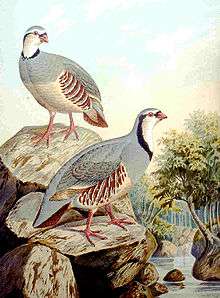 Rock partridge
Rock partridge
Alectoris graeca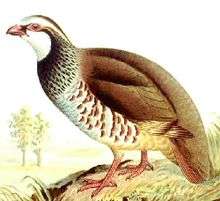 Red-legged partridge
Red-legged partridge
Alectoris rufa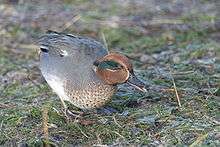 Green-winged teal
Green-winged teal
Anas crecca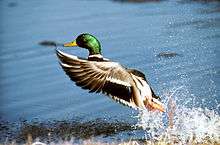 Mallard
Mallard
Anas platyrhynchos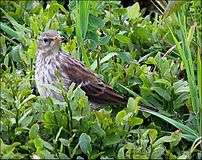 Water pipit
Water pipit
Anthus spinoletta.jpg) Tree pipit
Tree pipit
Anthus trivialis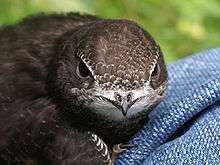 Common swift
Common swift
Apus apus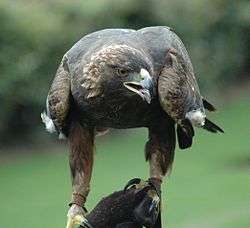 Golden eagle
Golden eagle
Aquila chrysaetos Great egret
Great egret
Ardea alba.jpg) Gray heron
Gray heron
Ardea cinerea Purple heron
Purple heron
Ardea purpurea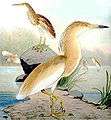 Squacco heron
Squacco heron
Ardeola ralloides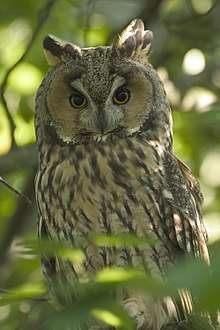 Long-eared owl
Long-eared owl
Asio otus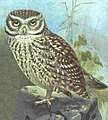 Little owl
Little owl
Athene noctua Common pochard
Common pochard
Aythya ferina Tufted duck
Tufted duck
Aythya fuligula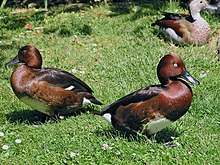 Ferruginous duck
Ferruginous duck
Aythya nyroca
B
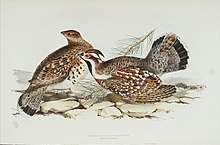 Hazel grouse
Hazel grouse
Bonasa bonasia.jpg) Great bittern
Great bittern
Botaurus stellaris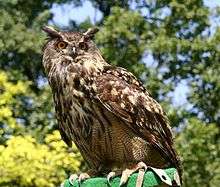 Eurasian eagle-owl
Eurasian eagle-owl
Bubo bubo Cattle egret
Cattle egret
Bubulcus ibis Eurasian thick-knee
Eurasian thick-knee
Burhinus oedicnemus Common buzzard
Common buzzard
Buteo buteo
C
- Greater short-toed lark
Calandrella brachydactyla  Cory's shearwater
Cory's shearwater
Calonectris diomedea European nightjar
European nightjar
Caprimulgus europaeus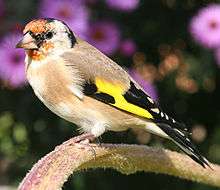 European goldfinch
European goldfinch
Carduelis carduelis.jpg) European greenfinch
European greenfinch
Chloris chloris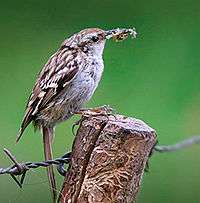 Short-toed treecreeper
Short-toed treecreeper
Certhia brachydactyla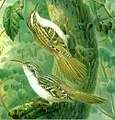 Common treecreeper
Common treecreeper
Certhia familiaris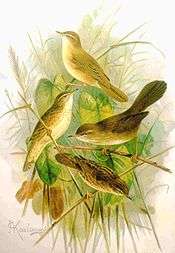 Cetti's warbler
Cetti's warbler
Cettia cetti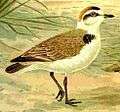 Kentish plover
Kentish plover
Charadrius alexandrinus Little ringed plover
Little ringed plover
Charadrius dubius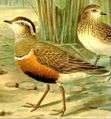 Eurasian dotterel
Eurasian dotterel
Charadrius morinellus Whiskered tern
Whiskered tern
Chlidonias hybrida.jpg) White-winged tern
White-winged tern
Chlidonias leucopterus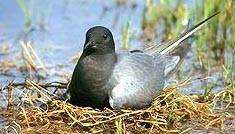 Black tern
Black tern
Chlidonias niger Black-headed gull
Black-headed gull
Chroicocephalus ridibundus White stork
White stork
Ciconia ciconia.jpg) Black stork
Black stork
Ciconia nigra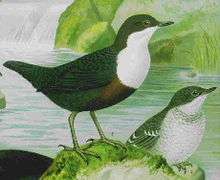 White-throated dipper
White-throated dipper
Cinclus cinclus- Short-toed snake-eagle
Circaetus gallicus 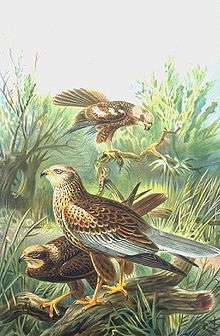 Marsh harrier
Marsh harrier
Circus aeruginosus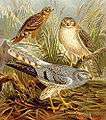 Montagu's harrier
Montagu's harrier
Circus pygargus Zitting cisticola
Zitting cisticola
Cisticola juncidis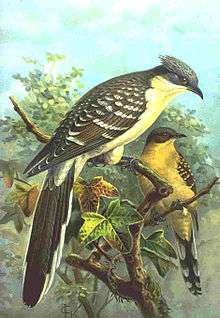 Great spotted cuckoo
Great spotted cuckoo
Clamator glandarius.jpg) Hawfinch
Hawfinch
Coccothraustes coccothraustes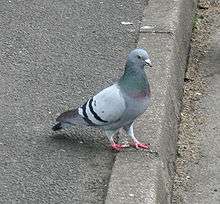 Rock pigeon
Rock pigeon
Columba livia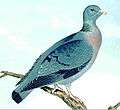 Stock pigeon
Stock pigeon
Columba oenas Common wood pigeon
Common wood pigeon
Columba palumbus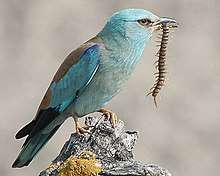 European roller
European roller
Coracias garrulus.jpg) Common raven
Common raven
Corvus corax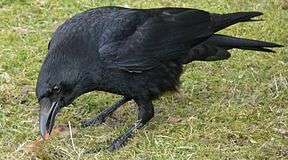 Carrion crow
Carrion crow
Corvus corone Eurasian jackdaw
Eurasian jackdaw
Corvus monedula.jpg) Common quail
Common quail
Coturnix coturnix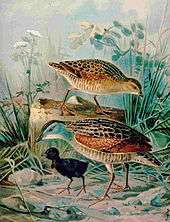 Corn crake
Corn crake
Crex crex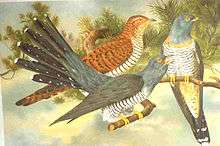 Common cuckoo
Common cuckoo
Cuculus canorus Mute swan
Mute swan
Cygnus olor
D
- Common house-martin
Delichon urbica 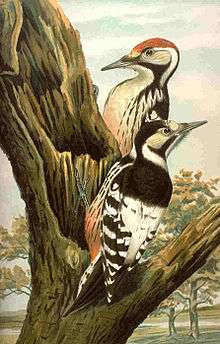 White-backed woodpecker
White-backed woodpecker
Dendrocopos leucotos.jpg) Great spotted woodpecker
Great spotted woodpecker
Dendrocopos major Middle spotted woodpecker
Middle spotted woodpecker
Dendrocoptes medius Lesser spotted woodpecker
Lesser spotted woodpecker
Dryobates minor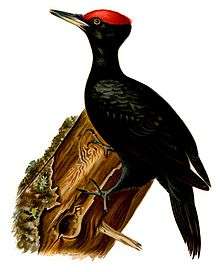 Black woodpecker
Black woodpecker
Dryocopus martius
E
 Little egret
Little egret
Egretta garzetta Rock bunting
Rock bunting
Emberiza cia Cirl bunting
Cirl bunting
Emberiza cirlus.jpg) Yellowhammer
Yellowhammer
Emberiza citrinella Ortolan bunting
Ortolan bunting
Emberiza hortulana Black-headed bunting
Black-headed bunting
Emberiza melanocephala Reed bunting
Reed bunting
Emberiza schoeniclus European robin
European robin
Erithacus rubecula
F
 Lanner falcon
Lanner falcon
Falco biarmicus Eleonora's falcon
Eleonora's falcon
Falco eleonorae Lesser kestrel
Lesser kestrel
Falco naumanni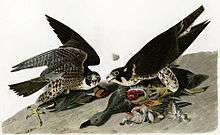 Peregrine falcon
Peregrine falcon
Falco peregrinus Eurasian hobby
Eurasian hobby
Falco subbuteo Common kestrel
Common kestrel
Falco tinnunculus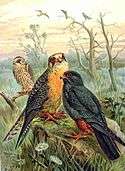 Red-footed falcon
Red-footed falcon
Falco vespertinus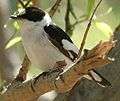 Collared flycatcher
Collared flycatcher
Ficedula albicollis Common chaffinch
Common chaffinch
Fringilla coelebs Eurasian coot
Eurasian coot
Fulica atra
G
 Crested lark
Crested lark
Galerida cristata Common snipe
Common snipe
Gallinago gallinago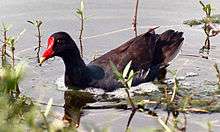 Eurasian moorhen
Eurasian moorhen
Gallinula chloropus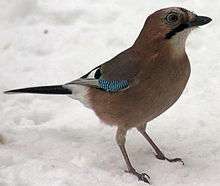 Eurasian jay
Eurasian jay
Garrulus glandarius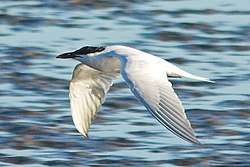 Gull-billed tern
Gull-billed tern
Gelochelidon nilotica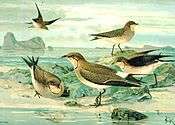 Collared pratincole
Collared pratincole
Glareola pratincola Eurasian pygmy-owl
Eurasian pygmy-owl
Glaucidium passerinum Bearded vulture
Bearded vulture
Gypaetus barbatus- Eurasian griffon
Gyps fulvus
H
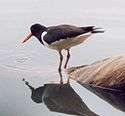 Eurasian oystercatcher
Eurasian oystercatcher
Haematopus ostralegus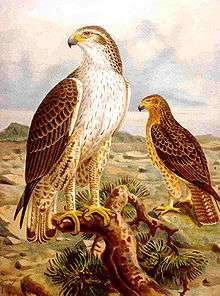 Bonelli's eagle
Bonelli's eagle
Hieraaetus fasciatus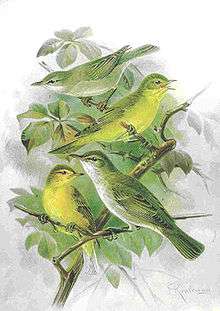 Melodious warbler
Melodious warbler
Hippolais polyglotta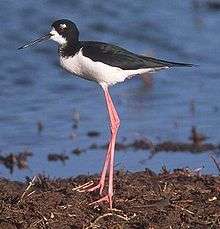 Black-winged stilt
Black-winged stilt
Himantopus himantopus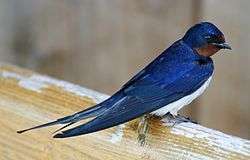 Barn swallow
Barn swallow
Hirundo rustica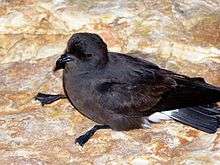 European storm-petrel
European storm-petrel
Hydrobates pelagicus
I
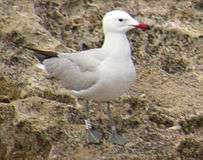 Audouin's gull
Audouin's gull
Ichthyaetus audouinii Mediterranean gull
Mediterranean gull
Ichthyaetus melanocephalus.jpg) Little bittern
Little bittern
Ixobrychus minutus
J
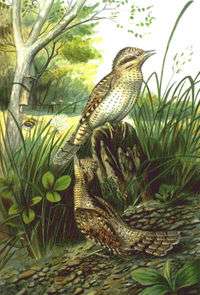 Eurasian wryneck
Eurasian wryneck
Jynx torquilla
L
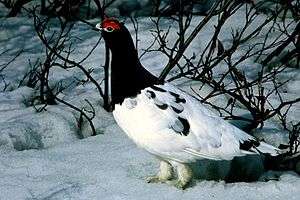 Rock ptarmigan
Rock ptarmigan
Lagopus muta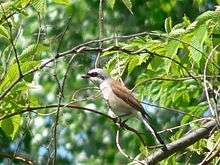 Red-backed shrike
Red-backed shrike
Lanius collurio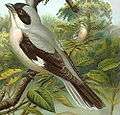 Lesser gray shrike
Lesser gray shrike
Lanius minor Woodchat shrike
Woodchat shrike
Lanius senator.jpg) Caspian gull
Caspian gull
Larus cachinnans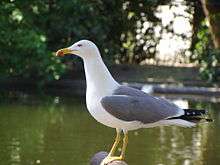 Yellow-legged gull
Yellow-legged gull
Larus michahellis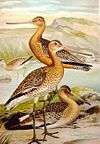 Black-tailed godwit
Black-tailed godwit
Limosa limosa Eurasian linnet
Eurasian linnet
Linaria cannabina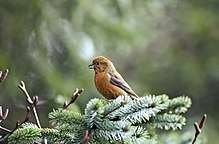 Common crossbill
Common crossbill
Loxia curvirostra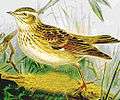 Wood lark
Wood lark
Lullula arborea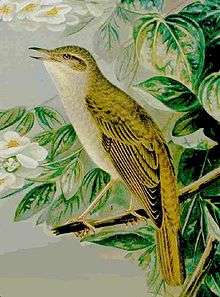 Common nightingale
Common nightingale
Luscinia megarhynchos
M
 Gadwall
Gadwall
Mareca strepera Calandra lark
Calandra lark
Melanocorypha calandra.jpg) European bee-eater
European bee-eater
Merops apiaster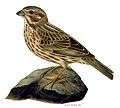 Corn bunting
Corn bunting
Miliaria calandra Black kite
Black kite
Milvus migrans Red kite
Red kite
Milvus milvus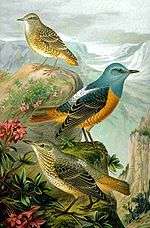 Rufous-tailed rock-thrush
Rufous-tailed rock-thrush
Monticola saxatilis Blue rock-thrush
Blue rock-thrush
Monticola solitarius White-winged snowfinch
White-winged snowfinch
Montifringilla nivalis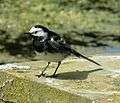 White wagtail
White wagtail
Motacilla alba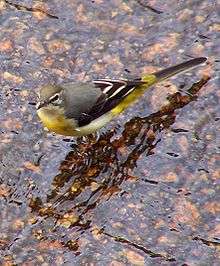 Gray wagtail
Gray wagtail
Motacilla cinerea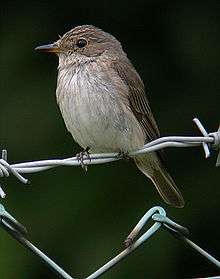 Spotted flycatcher
Spotted flycatcher
Muscicapa striata
N
 Egyptian vulture
Egyptian vulture
Neophron percnopterus_Male%2C_London_Wetland_Centre_-_Diliff.jpg) Red-crested pochard
Red-crested pochard
Netta rufina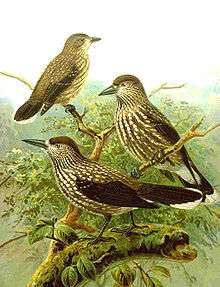 Spotted nutcracker
Spotted nutcracker
Nucifraga caryocatactes Black-crowned night-heron
Black-crowned night-heron
Nycticorax nycticorax
O
 Northern wheatear
Northern wheatear
Oenanthe oenanthe Eurasian golden oriole
Eurasian golden oriole
Oriolus oriolus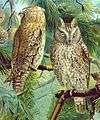 European scops-owl
European scops-owl
Otus scops
P
 Bearded reedling
Bearded reedling
Panurus biarmicus.jpg) Coal tit
Coal tit
Parus ater Blue tit
Blue tit
Parus caeruleus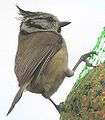 Crested tit
Crested tit
Parus cristatus.jpg) Great tit
Great tit
Parus major.jpg) Willow tit
Willow tit
Parus montanus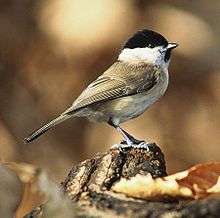 Marsh tit
Marsh tit
Parus palustris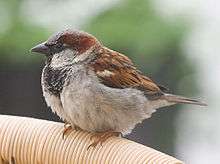 House sparrow
House sparrow
Passer domesticus Spanish sparrow
Spanish sparrow
Passer hispaniolensis Tree sparrow
Tree sparrow
Passer montanus.jpg) Gray partridge
Gray partridge
Perdix perdix- European honey-buzzard
Pernis apivorus - Rock sparrow
Petronia petronia 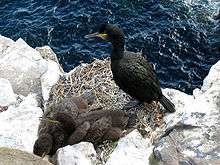 Common shag
Common shag
Phalacrocorax aristotelis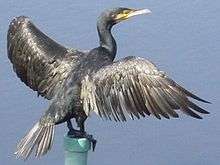 Great cormorant
Great cormorant
Phalacrocorax carbo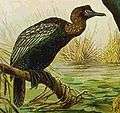 Pygmy cormorant
Pygmy cormorant
Microcarbo pygmeus.jpg) Ring-necked pheasant
Ring-necked pheasant
Phasianus colchicus Black redstart
Black redstart
Phoenicurus ochruros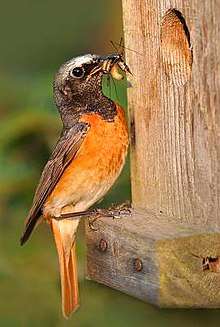 Common redstart
Common redstart
Phoenicurus phoenicurus Western Bonelli's warbler
Western Bonelli's warbler
Phylloscopus bonelli Common chiffchaff
Common chiffchaff
Phylloscopus collybita Wood warbler
Wood warbler
Phylloscopus sibilatrix European magpie
European magpie
Pica pica Eurasian three-toed woodpecker
Eurasian three-toed woodpecker
Picoides tridactylus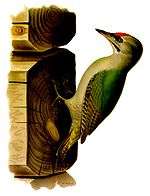 Gray-headed woodpecker
Gray-headed woodpecker
Picus canus Green woodpecker
Green woodpecker
Picus viridis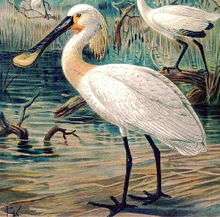 Eurasian spoonbill
Eurasian spoonbill
Platalea leucorodia Glossy ibis
Glossy ibis
Plegadis falcinellus.jpg) Great crested grebe
Great crested grebe
Podiceps cristatus Western swamphen
Western swamphen
Porphyrio porphyrio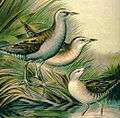 Little crake
Little crake
Porzana parva Spotted crake
Spotted crake
Porzana porzana Alpine accentor
Alpine accentor
Prunella collaris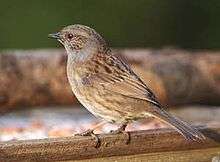 Dunnock
Dunnock
Prunella modularis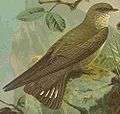 Eurasian crag-martin
Eurasian crag-martin
Ptyonoprogne rupestris Alpine chough
Alpine chough
Pyrrhocorax graculus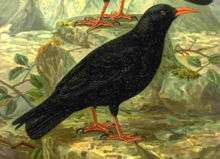 Red-billed chough
Red-billed chough
Pyrrhocorax pyrrhocorax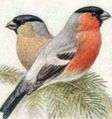 Eurasian bullfinch
Eurasian bullfinch
Pyrrhula pyrrhula
R
.jpg) Water rail
Water rail
Rallus aquaticus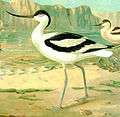 Pied avocet
Pied avocet
Recurvirostra avosetta- Firecrest
Regulus ignicapillus 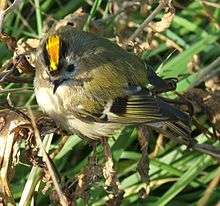 Goldcrest
Goldcrest
Regulus regulus.jpg) Eurasian penduline-tit
Eurasian penduline-tit
Remiz pendulinus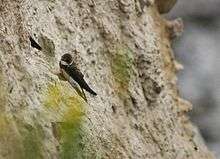 Bank swallow
Bank swallow
Riparia riparia
S
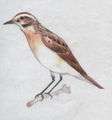 Whinchat
Whinchat
Saxicola rubetra.jpg) European stonechat
European stonechat
Saxicola rubicola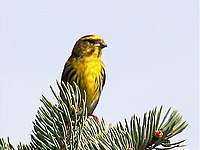 European serin
European serin
Serinus serinus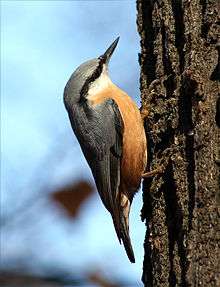 Eurasian nuthatch
Eurasian nuthatch
Sitta europaea Northern shoveler
Northern shoveler
Spatula clypeata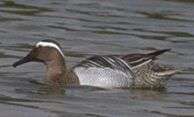 Garganey
Garganey
Spatula querquedula.jpg) Eurasian siskin
Eurasian siskin
Spinus spinus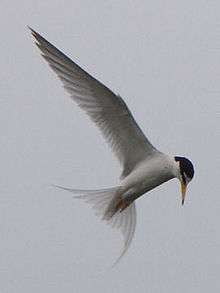 Little tern
Little tern
Sternula albifrons Common tern
Common tern
Sterna hirundo Eurasian collared-dove
Eurasian collared-dove
Streptopelia decaocto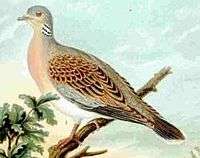 European turtle-dove
European turtle-dove
Streptopelia turtur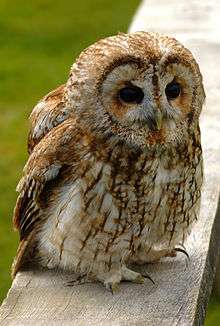 Tawny owl
Tawny owl
Strix aluco Ural owl
Ural owl
Strix uralensis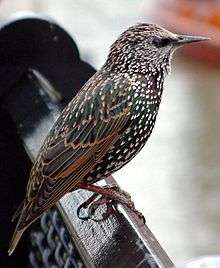 European starling
European starling
Sturnus vulgaris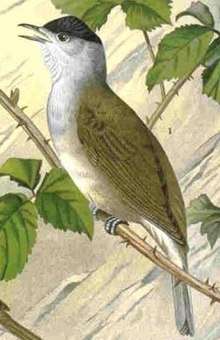 Eurasian blackcap
Eurasian blackcap
Sylvia atricapilla Garden warbler
Garden warbler
Sylvia borin Subalpine warbler
Subalpine warbler
Sylvia cantillans Greater whitethroat
Greater whitethroat
Sylvia communis Lesser whitethroat
Lesser whitethroat
Sylvia curruca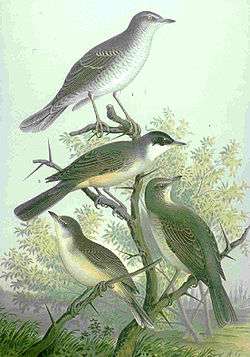 Western Orphean warbler
Western Orphean warbler
Sylvia hortensis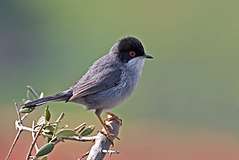 Sardinian warbler
Sardinian warbler
Sylvia melanocephala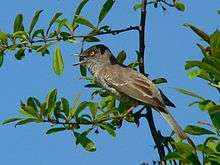 Barred warbler
Barred warbler
Sylvia nisoria
T
.jpg) Little grebe
Little grebe
Tachybaptus ruficollis Alpine swift
Alpine swift
Tachymarptis melba.jpg) Common shelduck
Common shelduck
Tadorna tadorna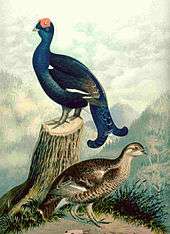 Black grouse
Black grouse
Tetrao tetrix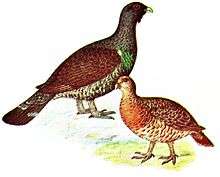 Western capercaillie
Western capercaillie
Tetrao urogallus Little bustard
Little bustard
Tetrax tetrax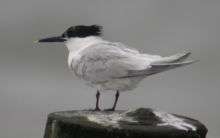 Sandwich tern
Sandwich tern
Thalasseus sandvicensis Lesser crested tern
Lesser crested tern
Thalasseus bengalensis Wallcreeper
Wallcreeper
Tichodroma muraria Common redshank
Common redshank
Tringa totanus Eurasian wren
Eurasian wren
Troglodytes troglodytes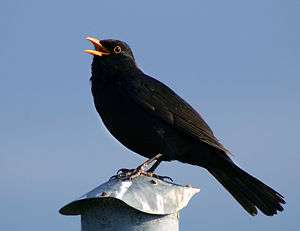 Eurasian blackbird
Eurasian blackbird
Turdus merula Song thrush
Song thrush
Turdus philomelos Fieldfare
Fieldfare
Turdus pilaris Ring ouzel
Ring ouzel
Turdus torquatus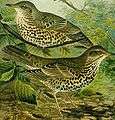 Mistle thrush
Mistle thrush
Turdus viscivorus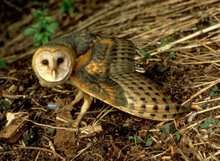 Barn owl
Barn owl
Tyto alba
V
.jpg) Northern lapwing
Northern lapwing
Vanellus vanellus
References
- Lepage, Denis (December 28, 2019). "Checklist of birds of Italy". Bird Checklists of the World. Avibase. Retrieved February 3, 2020.
- Clements, J. F., T. S. Schulenberg, M. J. Iliff, S. M. Billerman, T. A. Fredericks, B. L. Sullivan, and C. L. Wood. 2019. The eBird/Clements Checklist of Birds of the World: v2019. Downloaded from http://www.birds.cornell.edu/clementschecklist/download/ Retrieved August 15, 2019
- Gill, F. and D. Donsker (Eds). 2019. IOC World Bird List (v 9.2). doi:10.14344/IOC.ML.9.2. http://www.worldbirdnames.org/ retrieved 22 June 2019